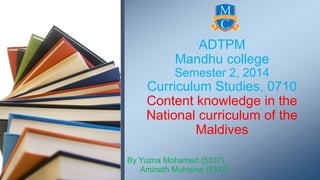Curriculum studies
- 1. ADTPM Mandhu college Semester 2, 2014 Curriculum Studies, 0710 Content knowledge in the National curriculum of the Maldives By Yuzna Mohamed (5337) Aminath Muhisina (5372)
- 2. Contents âĒ Introduction âĒ Content related to our topic âĒ Our opinion and Justification
- 3. Introduction âĒ The chosen topic is âMathematicsâ from the new curriculum of Maldives.
- 4. Content âĒ There are 5 strands of mathematics. ïNumbers ïMeasurement ïShape and Space ïChance and Data ïPatterning and Algebra
- 5. Numbers ïž Number Concept ïž Addition and Subtraction ïž Multiplication & Division ïž Money ïž Fractions, Decimals
- 6. Measurement ïž Length ïž Mass ïž Capacity ïž Perimeter, Area and Volume ïž Time
- 7. Shape and Space ïž 3D Shapes ïž 2D Shapes ïž Positions and Directions ïž Angles ïž Handling Data
- 8. Chance and Handling Data ïž Handling Data ïž Sequences and Properties of Numbers ïž Investigations, Puzzles and Problems
- 9. Patterning and Algebra ïž Sequences and properties of Numbers ïž Investigations, Puzzles and problems.
- 10. Our opinion and justification ïž Good syllabus / very appropriate to the Maldivian society: âKnowledge, skills, values and attitudes taught through this subject would be a tool for the pupils to function and excel in all aspects of life. It also helps to think logically, be creative, solve problems and appreciate the esthetics of Allah (SWT)âs creation.â
- 11. Our opinion and justification ïž Principles: ïž No gaps in-between the grades. ïž Interesting (investigations, puzzles) ânumber system, computational skills, and the ability to solve simple problems related to their day to day life. Emphasis is also given to practical understanding of the ways in which information is gathered and presentedâ (NIE, 2014, p.6)
- 12. Our opinion and justification ïž Cross-Curricular and Integrated Learning ïž learn the process of enquiry, discovery and verification and to apply mathematical ideas, rules and procedures to particular situations and problems. ïž Students will explore, estimate and manipulate numbers to carry out day to day
- 13. Our opinion and justification ïž learn the process of enquiry, discovery and verification and to apply mathematical ideas, rules and procedures to particular situations and problems. ïž Students will explore, estimate and manipulate numbers to carry out day to day activities. ïž equip the students to estimate, measure
- 14. Our opinion and justification ïž contributes to the development of the student in all aspects. ïž would master in 3D & 2D shapes, positions, directions and angles. ïž Students would be able to visualize spatial aspects of things and perceive them better. ïž Students would be able to represent and interpret different data collected in a
- 15. Our opinion and justification ïž Studentsâ confidence is built by helping them to develop a feel for numbers, their properties, and the relationships. Algebra is one of the very important topics that students learn in their entire schooling, which
- 16. Conclusion ïž There are five strands ïž Sub-strands and topics. ïž Difference in each level but no gaps in-between. ïž Give students opportunities to learn in a variety of ways âindividually, cooperatively, independently, with teacherâs direction, through hands-on experience, through examples followed
- 17. Conclusion ïž Teachers should vary strategies according to both the object of the learning and the needs of the students. ïž Students must develop a solid understanding of mathematical concepts.
- 18. Conclusion ïž Teachers need to use rich problems and present situations that provide a variety of opportunities for students to develop mathematical understanding through problem solving.
- 19. Reference ïž NIE (2014) Mathematics in the National Curriculum. [ONLINE] Available at: http://nie.edu.mv/sites/default/files/Mathematics%20Syllabus%20KS1%20Final %2026th%20August%202014.pdf. [Accessed 09 September 14]



















![Reference
ïž NIE (2014) Mathematics in the National Curriculum. [ONLINE] Available at:
http://nie.edu.mv/sites/default/files/Mathematics%20Syllabus%20KS1%20Final
%2026th%20August%202014.pdf. [Accessed 09 September 14]](https://image.slidesharecdn.com/curriculumpresentation-140917001616-phpapp02/85/Curriculum-studies-19-320.jpg)
